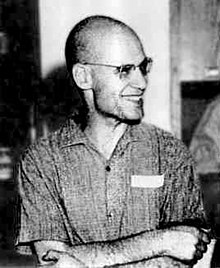Alexander Grothendieck | |
|---|---|
 Alexander Grothendieck in Montréal, 1970 | |
| Born | 28 March 1928 |
| Died | 13 November 2014 (aged 86) Saint-Lizier, Ariège, France |
| Nationality | |
| Alma mater | |
| Known for | Renewing algebraic geometry and synthesis between it and number theory and topology List of things named after Alexander Grothendieck |
| Awards |
|
| Scientific career | |
| Fields | Functional analysis Algebraic geometry Homological algebra |
| Institutions | |
| Thesis | Produits tensoriels topologiques et espaces nucléaires (1953) |
| Doctoral advisors | |
| Doctoral students | |
Alexander Grothendieck, later Alexandre Grothendieck in French (/ˈɡroʊtəndiːk/; German: [ˌalɛˈksandɐ ˈɡʁoːtn̩ˌdiːk] ; French: [ɡʁɔtɛndik]; 28 March 1928 – 13 November 2014), was a German-born French mathematician who became the leading figure in the creation of modern algebraic geometry.[7][8] His research extended the scope of the field and added elements of commutative algebra, homological algebra, sheaf theory, and category theory to its foundations, while his so-called "relative" perspective led to revolutionary advances in many areas of pure mathematics.[7][9] He is considered by many to be the greatest mathematician of the twentieth century.[10][11]
Grothendieck began his productive and public career as a mathematician in 1949. In 1958, he was appointed a research professor at the Institut des hautes études scientifiques (IHÉS) and remained there until 1970, when, driven by personal and political convictions, he left following a dispute over military funding. He received the Fields Medal in 1966 for advances in algebraic geometry, homological algebra, and K-theory.[12] He later became professor at the University of Montpellier[1] and, while still producing relevant mathematical work, he withdrew from the mathematical community and devoted himself to political and religious pursuits (first Buddhism and later, a more Catholic Christian vision).[13] In 1991, he moved to the French village of Lasserre in the Pyrenees, where he lived in seclusion, still working on mathematics and his philosophical and religious thoughts until his death in 2014.[14]
- ^ a b Scharlau 2008.
- ^ Cartier et al. 2007, p. 7.
- ^ Cartier 2004.
- ^ a b Douroux 2012.
- ^ Cartier 2004, p. 10, footnote 12.
- ^ Kleinert 2007.
- ^ a b Jackson 2004b.
- ^ Bruce Weber; Julie Rehmeyer (14 November 2014). "Alexander Grothendieck, Math Enigma, Dies at 86". The New York Times. Archived from the original on 1 January 2022.
- ^ Mumford, David; Tate, John (2015). "Alexander Grothendieck (1928–2014) Mathematician who rebuilt algebraic geometry". Nature. 517 (7534): 272. Bibcode:2015Natur.517..272M. doi:10.1038/517272a. ISSN 0028-0836. PMID 25592527.
- ^ "Guardian obituary". Independent.co.uk.
- ^ Cite error: The named reference
obitwas invoked but never defined (see the help page). - ^ "Fields Medals 1966". mathunion.org. Archived from the original on 22 March 2019. Retrieved 5 January 2022.
- ^ Scharlau, Winfried. "Who is Alexander Grothendieck? Anarchy, Mathematics, Spirituality, Solitude" (PDF). Archived (PDF) from the original on 9 October 2022.
- ^ Ruelle 2007, p. 40.